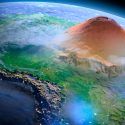Akiko Iwasaki thought she was safe. The hotel she owned was designed to double as a tsunami evacuation spot. But when a 14.5 m (48 ft) monster wave hit Japan on March 11, 2011, the lower levels of the building were completely destroyed. Iwasaki tried to run for higher ground, but her efforts were futile. She wasn’t ready to give up, but would her survival instincts be enough to win a fight against the rushing waters? Tsunamis are powerful enough to move enormous buildings, uproot trees and submerge entire towns within seconds. You can only imagine what they can do to a person. We’re about to tell you the stories of three extraordinary people whose incredible strength and resilience helped them survive these unstoppable forces of nature. How did a cable save a man’s life? How far inland should you be to be safe? And why shouldn’t you try to swim?
Number 3: Holding On
In 2018 a devastating tsunami hit Indonesia. Muhlis Ipul lived in Petobo, one of the regions affected by the disaster. He was home with his wife and two daughters when the ground started to shake. They ran outside and saw the asphalt breaking up. Ipul became trapped as the road crumbled underneath him, causing him to lose hold of one of his daughters. The combination of raging water and dirt being pulled upward created muddy, fast-moving quicksand. He lay pinned in the darkness until the flowing mud knocked him loose. Ipul managed to grab a cable and use it as a safety line. Finally, he was tossed onto a higher spot where he stayed and tried to look for signs of his wife and daughters, but they were never found.
Number 2: A Black Wall
Christine Lang was shopping in a store on the island of Ko Phi Phi, Thailand, when the 2004 Indonesian earthquake occurred. Suddenly, people started to run inland but Lang didn’t understand why. Then she saw the massive black wall of water coming toward her. She became tangled underwater among the debris, but another wave pushed her out of the trap. She was blasted toward the surface after keeping her limbs close to her body to avoid being hurt by the objects hitting her. Lang blacked out and came to about 50 m (164 ft) underwater. Through the darkness, she saw a ring of light and swam in that direction. When she reached the surface, she was pulled onto the roof of a house. After the water levels dropped, she made her way to a nearby hotel where other survivors were already gathering. Let’s take a moment to see what we’ve learned from these unbelievable stories. Running inland, just like Christine Lang saw people do, can keep you safe. You should still try to be at least 3.2 km (2 mi) from the water’s edge. Get to higher ground by any means necessary. For that, you can get a grasp of any object that is stable enough to pull you up. If you are caught up in a wave, wrap your arms around yourself, fold your knees in and cover your face. There’s no swimming through waves like this, and it will protect your vital organs from debris that is guaranteed to hit you.
Number 1: No One’s Safe
Now, back to Iwasaki’s story. After her hotel was flooded, Iwasaki’s daughter saw her disappear into the water. She watched in horror as her mother was sucked into a whirlpool filled with everything the wave had bulldozed, including cars and debris from surrounding buildings.
When she did see the surface, a boat was blocking her way. With the last of her strength, she pushed it aside and was able to gasp for air.
Iwasaki emerged on a hillside about 15 m (49 ft) away from where the water first swallowed her. She lost friends and co-workers but was eventually reunited with her daughter. Hopefully, these stories have shown you that no matter how bad things might be during a natural disaster, there’s always a way to make it out alive.
Sources
- We’ve been following victims of the Boxing Day tsunami for 16 years – this is what we’ve learned about recovering from disaster. Rante, Ardiles (2021). The Conversation.
- The Deadliest Tsunamis (2022). SMS Tsunami Warnings.
- Survivors Recall Deadly Earthquake And Tsunami In Indonesia. McCarthy, J. (2018). NPR
- How to survive a tsunami. Baggaley, K. (2021). Popular Science.
- Tsunamis: Before, During & After. Canadian Red Cross (2022).
















